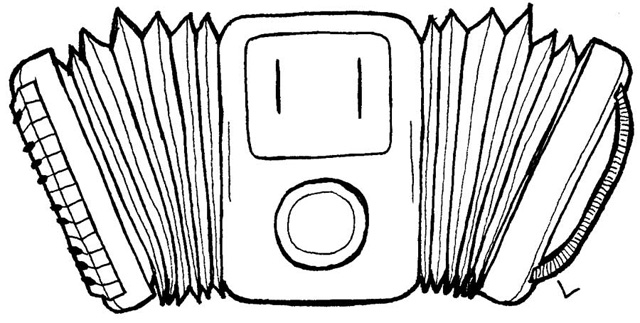
My favorite trend in MP3 players and music-phones is the inclusion of a slot for a ridiculously tiny microSD card. There’s just something really cool about taking a 2GB memory card out of my LG Chocolate phone and putting it into my SanDisk Sansa e280. But high-capacity memory cards also have the potential to resolve thorny issues related to digital music sharing — especially across your own devices.
MP3 players have had expansion slots for years, but until now they supported a max of only 2 extra gigabytes on top of the built-in memory. Well, according to a new spec, those fingernail-size microSD cards can now hit up to 32GB–enough to warrant rethinking the role of flash memory in an MP3 player. Luckily, cell phone and digicam makers provide plenty of inspiration!
Beating Moore’s Law
Moore’s Law states that every two years, microchips double in complexity (i.e., number of transistors) while maintaining minimum cost. Flash memory is nothing more than a microchip, and it’s not just following Moore’s law, it’s cruising at an even faster pace.
The SD Card Association’s new SDA 2.00 spec — which includes all Secure Digital formats, like miniSD and microSD — allows for cards up to 32GB, thanks to a change in file systems from FAT16 to FAT32. (Current devices aren’t compatible with the new spec, but they can be brought up to speed via a firmware upgrade.)
8GB microSD cards should be in stores by the end of this year (or early 2008) if Samsung holds to their recent announcement, and it’s a good bet someone’ll announce a 16GB microSD card by summer’s end for release next year.
You can already find 4GB players for $150 or less online, so by this time next year, 8GB players should be hitting or nearing the same price point. A 4GB SD card costs about $90 right now, so an 8GB card should be about $120 by the time it arrives in stores.
Confused? It means you’ll be able to get a player with a total of 16GB of flash for about $230 by next summer — not bad, especially considering you’ll be able to shuttle half that between your MP3 player, phone, GPS, HDTV, and (if automakers really get smart) dashboard. And lest I forget to mention it, you can move stuff on and off your computer via your laptop’s built-in card reader or a cheap external one.
SanDisk has long been ahead of the curve on expandable storage. According to Eric Bone, SanDisk’s director of audio/video product marketing, “The SanDisk e200, c200 and Connect families all (today) support up to 2GB microSD cards. We are working on firmware upgrades as we speak to get us to SDHC compliance, which clearly will give the products lots of headroom.”
Sharing Is Caring
Getting tons of music and videos onto a fingernail-size card is great, but you generally can’t transfer content between cards and music players — though there are a few exceptions like the Creative Zen Vision and some older Archos players. Everyone wants to do that wirelessly, but Wi-Fi really puts a hurtin’ on battery life… and will for the foreseeable future. Plus you’re not always near a hotspot, and Bluetooth is still way too slow for copying lots of music or video.
One of the reasons most manufacturers won’t let you transfer files to and from cards is to cover their asses limit possible company liabilities if the RIAA ever decides to crack down on hardware companies. But the industry’s stranglehold on music appears to be loosening, given recent developments on the DRM front, and I think hardware makers should help pave the way for a better sharing experience.
They can do this by looking to the digital camera market: Most digital cameras come with little if any internal flash memory. You get a starter card (nearly always uselessly small), you get a bundled card (usually at least 1GB), or you already have a suitable memory card. This strategy could easily be a huge hit in the MP3 player market within a year or two as flash prices continue to plummet and capacities increase.
DRM seems to be disappearing — at least for digital music — indicating a sea change in the attitudes of the recording industry towards sharing music. It’s time for MP3 player companies to start changing with the times and let us transfer content to and from removable media.
Then perhaps people will be more apt to share music one-on-one — especially among their own gadgets — rather than illegally distributing it to thousands of people at a time on a P2P network.
(The illustration above was created by Leah Perrotta, a Brooklyn-based artist and all-around lovely gal.)